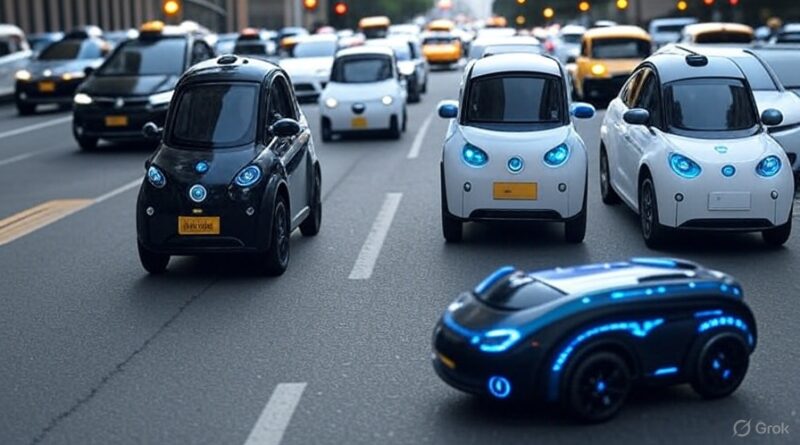Longterm Robotaxis Will Go from Hype to Maybe, Possibly, Profit
The idea of robotaxis once promised a transport revolution. Self-driving cars were going to replace human drivers, cut accidents, operate around the clock, and make ride-hailing cheaper and safer. Billions were invested. Companies promised breakthroughs year after year. But now, in 2025, the story has changed. Instead of world-changing disruption, robotaxis are progressing slowly. Some projects are working. Some aren’t. A few might even be close to making money. Here’s what’s really happening in the world of robotaxis right now.
The Hype Was Massive – The Reality Is Slower
From 2016 to 2021, names like Waymo, Cruise, Tesla, and Uber made huge promises. Investors believed that by 2022, we’d all be hailing robotaxis instead of Ubers or black cabs.
They claimed that driverless cars would:
- Eliminate human error
- Drop ride costs dramatically (that would never change as companies would want all the profit)
- Solve traffic congestion
- Run 24/7 without breaks
But these promises collided with real-world problems. Roads are chaotic. Software still struggles with unpredictable human behaviour. And after several high-profile accidents, public trust dropped.
The technology wasn’t ready. Cities weren’t ready. And regulation was slow to catch up.
Where Robotaxis Actually Work in 2025
Although most robotaxi talk has gone quiet, some companies are operating small fleets in selected cities.
Waymo – Phoenix and San Francisco
Waymo runs a commercial robotaxi service in parts of Phoenix and San Francisco. Riders can book trips through an app. There’s no driver in the front seat.
But: services are limited to specific zones. Vehicles often stop if they encounter unusual situations.
Cruise – Austin and Dallas
Cruise, backed by General Motors, operates in limited areas with strict rules. After a crash in late 2023, they paused operations but resumed with tighter safety controls.
Most of their current trips are low-speed and geofenced.
Baidu and AutoX – China
China has moved faster than the West. Baidu’s Apollo Go and AutoX run robotaxis in cities like Beijing and Shenzhen. However, most still use remote monitoring and operate in restricted zones.
Are Robotaxis Making Money?
Not yet.
Right now, every major robotaxi service still loses money. Here’s why:
- Expensive sensors and computing hardware
- Backup systems for safety (brakes, steering, power)
- High development and testing costs
- Remote monitoring and human support
- Limited operating areas mean low vehicle usage
Even though these cars don’t have drivers, the cost per mile is still higher than Uber or traditional taxis in most cities.
When Will Robotaxis Become Profitable?
Analysts believe true profitability is unlikely before 2028 to 2035. The timeline depends on:
- Reduced hardware costs (especially sensors and chips)
- Better software handling complex environments
- Higher fleet usage across full city networks
- Relaxed legal requirements and insurance premiums
Until then, most companies are focused on proving the technology works in small, controlled steps.
What’s Slowing Things Down?
- Urban Complexity
Robotaxis still struggle with pedestrians, cyclists, unexpected roadworks, and rare situations that humans can handle easily. - Legal Uncertainty
Governments haven’t fully decided who’s liable in a driverless crash. That makes insurers nervous. - Public Trust
After years of bold claims and a few scary accidents, many people still aren’t ready to get into a car without a driver. - Tech Limitations
Even with AI, these systems are expensive, power-hungry, and can still make mistakes in the real world.
From Disruption to Business Model
The focus has shifted from trying to change the world overnight to finding a working business case. Companies like Waymo and Cruise are now:
- Expanding slowly into new neighbourhoods
- Improving reliability over speed
- Building trust before scale
Even Tesla, once the loudest voice in autonomy, has scaled back expectations and is now focused more on driver-assist systems than true robotaxis.
Final Thoughts – A Slow But Real Shift
Robotaxis are still coming, but not in the way we once expected. They are not replacing Uber everywhere just yet. But in specific cities, in specific conditions, they’re already operating.
They’re moving from science fiction to real but narrow use. From overhype to cautious testing. From big dreams to real revenue – slowly.
Robotaxis might not take over cities tomorrow, but they’re not a failure either. They’re just taking the long road to get there.
Buying a used VW. Buying used vauxhall, BMW, Jaguar, Ford, Volvo, Range rover, Bentley, Aston Martin, Porsche, Ferrari, Lamborghini, Maserati, Hyundai, Tesla, Honda, Pagani

